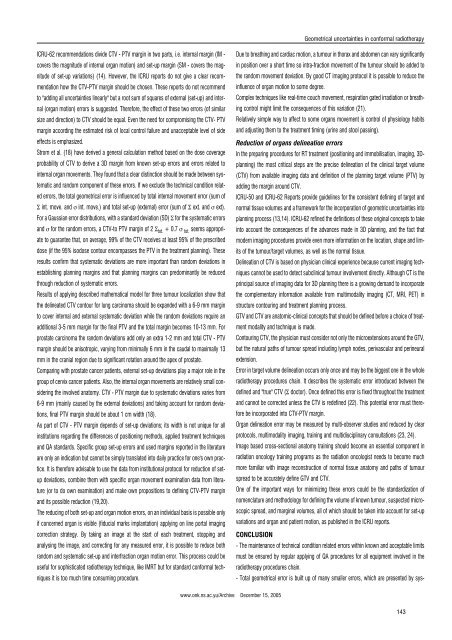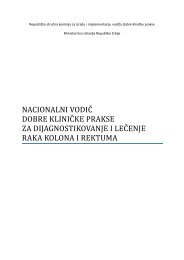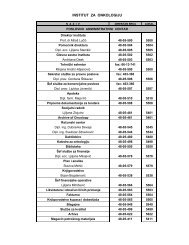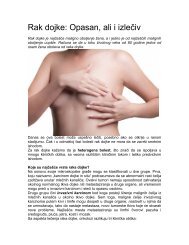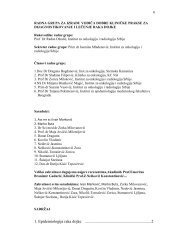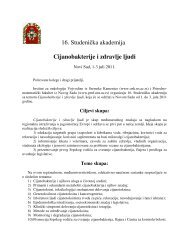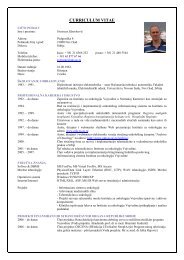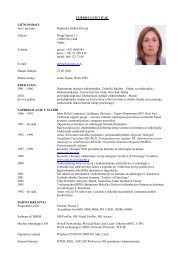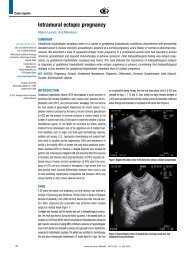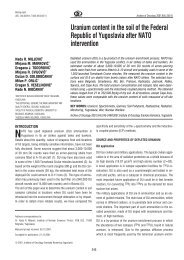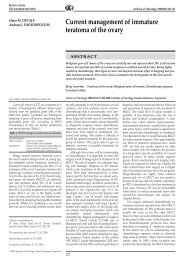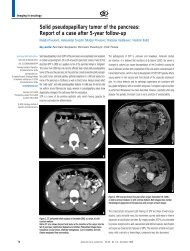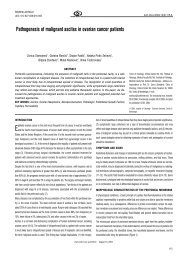Verification and correction of geometrical uncertainties in ... - doiSerbia
Verification and correction of geometrical uncertainties in ... - doiSerbia
Verification and correction of geometrical uncertainties in ... - doiSerbia
Create successful ePaper yourself
Turn your PDF publications into a flip-book with our unique Google optimized e-Paper software.
Geometrical <strong>uncerta<strong>in</strong>ties</strong> <strong>in</strong> conformal radiotherapy<br />
ICRU-62 recommendations divide CTV - PTV marg<strong>in</strong> <strong>in</strong> two parts, i.e. <strong>in</strong>ternal marg<strong>in</strong> (IM -<br />
covers the magnitude <strong>of</strong> <strong>in</strong>ternal organ motion) <strong>and</strong> set-up marg<strong>in</strong> (SM - covers the magnitude<br />
<strong>of</strong> set-up variations) (14). However, the ICRU reports do not give a clear recommendation<br />
how the CTV-PTV marg<strong>in</strong> should be chosen. These reports do not recommend<br />
to "add<strong>in</strong>g all <strong>uncerta<strong>in</strong>ties</strong> l<strong>in</strong>early" but a root sum <strong>of</strong> squares <strong>of</strong> external (set-up) <strong>and</strong> <strong>in</strong>ternal<br />
(organ motion) errors is suggested. Therefore, the effect <strong>of</strong> these two errors (<strong>of</strong> similar<br />
size <strong>and</strong> direction) to CTV should be equal. Even the need for compromis<strong>in</strong>g the CTV- PTV<br />
marg<strong>in</strong> accord<strong>in</strong>g the estimated risk <strong>of</strong> local control failure <strong>and</strong> unacceptable level <strong>of</strong> side<br />
effects is emphasized.<br />
Strom et al. (18) have derived a general calculation method based on the dose coverage<br />
probability <strong>of</strong> CTV to derive a 3D marg<strong>in</strong> from known set-up errors <strong>and</strong> errors related to<br />
<strong>in</strong>ternal organ movements. They found that a clear dist<strong>in</strong>ction should be made between systematic<br />
<strong>and</strong> r<strong>and</strong>om component <strong>of</strong> these errors. If we exclude the technical condition related<br />
errors, the total <strong>geometrical</strong> error is <strong>in</strong>fluenced by total <strong>in</strong>ternal movement error (sum <strong>of</strong><br />
S <strong>in</strong>t. move. <strong>and</strong> s <strong>in</strong>t. move.) <strong>and</strong> total set-up (external) error (sum <strong>of</strong> S ext. <strong>and</strong> s ext).<br />
For a Gaussian error distributions, with a st<strong>and</strong>ard deviation (SD) S for the systematic errors<br />
<strong>and</strong> s for the r<strong>and</strong>om errors, a CTV-to PTV marg<strong>in</strong> <strong>of</strong> 2 S tot. + 0.7 s tot. seems appropriate<br />
to guarantee that, on average, 99% <strong>of</strong> the CTV receives at least 95% <strong>of</strong> the prescribed<br />
dose (if the 95% isodose contour encompasses the PTV <strong>in</strong> the treatment plann<strong>in</strong>g). These<br />
results confirm that systematic deviations are more important than r<strong>and</strong>om deviations <strong>in</strong><br />
establish<strong>in</strong>g plann<strong>in</strong>g marg<strong>in</strong>s <strong>and</strong> that plann<strong>in</strong>g marg<strong>in</strong>s can predom<strong>in</strong>antly be reduced<br />
through reduction <strong>of</strong> systematic errors.<br />
Results <strong>of</strong> apply<strong>in</strong>g described mathematical model for three tumour localization show that<br />
the del<strong>in</strong>eated CTV contour for lung carc<strong>in</strong>oma should be exp<strong>and</strong>ed with a 6-9 mm marg<strong>in</strong><br />
to cover <strong>in</strong>ternal <strong>and</strong> external systematic deviation while the r<strong>and</strong>om deviations require an<br />
additional 3-5 mm marg<strong>in</strong> for the f<strong>in</strong>al PTV <strong>and</strong> the total marg<strong>in</strong> becomes 10-13 mm. For<br />
prostate carc<strong>in</strong>oma the r<strong>and</strong>om deviations add only an extra 1-2 mm <strong>and</strong> total CTV - PTV<br />
marg<strong>in</strong> should be anisotropic, vary<strong>in</strong>g from m<strong>in</strong>imally 6 mm <strong>in</strong> the caudal to maximally 13<br />
mm <strong>in</strong> the cranial region due to significant rotation around the apex <strong>of</strong> prostate.<br />
Compar<strong>in</strong>g with prostate cancer patients, external set-up deviations play a major role <strong>in</strong> the<br />
group <strong>of</strong> cervix cancer patients. Also, the <strong>in</strong>ternal organ movements are relatively small consider<strong>in</strong>g<br />
the <strong>in</strong>volved anatomy. CTV - PTV marg<strong>in</strong> due to systematic deviations varies from<br />
6-9 mm (ma<strong>in</strong>ly caused by the external deviations) <strong>and</strong> tak<strong>in</strong>g account for r<strong>and</strong>om deviations,<br />
f<strong>in</strong>al PTV marg<strong>in</strong> should be about 1 cm width (18).<br />
As part <strong>of</strong> CTV - PTV marg<strong>in</strong> depends <strong>of</strong> set-up deviations; its width is not unique for all<br />
<strong>in</strong>stitutions regard<strong>in</strong>g the differences <strong>of</strong> position<strong>in</strong>g methods, applied treatment techniques<br />
<strong>and</strong> QA st<strong>and</strong>ards. Specific group set-up errors <strong>and</strong> used marg<strong>in</strong>s reported <strong>in</strong> the literature<br />
are only an <strong>in</strong>dication but cannot be simply translated <strong>in</strong>to daily practice for one's own practice.<br />
It is therefore advisable to use the data from <strong>in</strong>stitutional protocol for reduction <strong>of</strong> setup<br />
deviations, comb<strong>in</strong>e them with specific organ movement exam<strong>in</strong>ation data from literature<br />
(or to do own exam<strong>in</strong>ation) <strong>and</strong> make own propositions to def<strong>in</strong><strong>in</strong>g CTV-PTV marg<strong>in</strong><br />
<strong>and</strong> its possible reduction (19,20).<br />
The reduc<strong>in</strong>g <strong>of</strong> both set-up <strong>and</strong> organ motion errors, on an <strong>in</strong>dividual basis is possible only<br />
if concerned organ is visible (fiducial marks implantation) apply<strong>in</strong>g on l<strong>in</strong>e portal imag<strong>in</strong>g<br />
<strong>correction</strong> strategy. By tak<strong>in</strong>g an image at the start <strong>of</strong> each treatment, stopp<strong>in</strong>g <strong>and</strong><br />
analys<strong>in</strong>g the image, <strong>and</strong> correct<strong>in</strong>g for any measured error, it is possible to reduce both<br />
r<strong>and</strong>om <strong>and</strong> systematic set-up <strong>and</strong> <strong>in</strong>terfraction organ motion error. This process could be<br />
useful for sophisticated radiotherapy technique, like IMRT but for st<strong>and</strong>ard conformal techniques<br />
it is too much time consum<strong>in</strong>g procedure.<br />
Due to breath<strong>in</strong>g <strong>and</strong> cardiac motion, a tumour <strong>in</strong> thorax <strong>and</strong> abdomen can vary significantly<br />
<strong>in</strong> position over a short time so <strong>in</strong>tra-fraction movement <strong>of</strong> the tumour should be added to<br />
the r<strong>and</strong>om movement deviation. By good CT imag<strong>in</strong>g protocol it is possible to reduce the<br />
<strong>in</strong>fluence <strong>of</strong> organ motion to some degree.<br />
Complex techniques like real-time couch movement, respiration gated irradiation or breath<strong>in</strong>g<br />
control might limit the consequences <strong>of</strong> this variation (21).<br />
Relatively simple way to affect to some organs movement is control <strong>of</strong> physiology habits<br />
<strong>and</strong> adjust<strong>in</strong>g them to the treatment tim<strong>in</strong>g (ur<strong>in</strong>e <strong>and</strong> stool pass<strong>in</strong>g).<br />
Reduction <strong>of</strong> organs del<strong>in</strong>eation errors<br />
In the prepar<strong>in</strong>g procedures for RT treatment (position<strong>in</strong>g <strong>and</strong> immobilisation, imag<strong>in</strong>g, 3Dplann<strong>in</strong>g)<br />
the most critical steps are the precise del<strong>in</strong>eation <strong>of</strong> the cl<strong>in</strong>ical target volume<br />
(CTV) from available imag<strong>in</strong>g data <strong>and</strong> def<strong>in</strong>ition <strong>of</strong> the plann<strong>in</strong>g target volume (PTV) by<br />
add<strong>in</strong>g the marg<strong>in</strong> around CTV.<br />
ICRU-50 <strong>and</strong> ICRU-62 Reports provide guidel<strong>in</strong>es for the consistent def<strong>in</strong><strong>in</strong>g <strong>of</strong> target <strong>and</strong><br />
normal tissue volumes <strong>and</strong> a framework for the <strong>in</strong>corporation <strong>of</strong> geometric <strong>uncerta<strong>in</strong>ties</strong> <strong>in</strong>to<br />
plann<strong>in</strong>g process (13,14). ICRU-62 ref<strong>in</strong>ed the def<strong>in</strong>itions <strong>of</strong> these orig<strong>in</strong>al concepts to take<br />
<strong>in</strong>to account the consequences <strong>of</strong> the advances made <strong>in</strong> 3D plann<strong>in</strong>g, <strong>and</strong> the fact that<br />
modern imag<strong>in</strong>g procedures provide even more <strong>in</strong>formation on the location, shape <strong>and</strong> limits<br />
<strong>of</strong> the tumour/target volumes, as well as the normal tissue.<br />
Del<strong>in</strong>eation <strong>of</strong> CTV is based on physician cl<strong>in</strong>ical experience because current imag<strong>in</strong>g techniques<br />
cannot be used to detect subcl<strong>in</strong>ical tumour <strong>in</strong>volvement directly. Although CT is the<br />
pr<strong>in</strong>cipal source <strong>of</strong> imag<strong>in</strong>g data for 3D plann<strong>in</strong>g there is a grow<strong>in</strong>g dem<strong>and</strong> to <strong>in</strong>corporate<br />
the complementary <strong>in</strong>formation available from multimodality imag<strong>in</strong>g (CT, MRI, PET) <strong>in</strong><br />
structure contour<strong>in</strong>g <strong>and</strong> treatment plann<strong>in</strong>g process.<br />
GTV <strong>and</strong> CTV are anatomic-cl<strong>in</strong>ical concepts that should be def<strong>in</strong>ed before a choice <strong>of</strong> treatment<br />
modality <strong>and</strong> technique is made.<br />
Contour<strong>in</strong>g CTV, the physician must consider not only the microextensions around the GTV,<br />
but the natural paths <strong>of</strong> tumour spread <strong>in</strong>clud<strong>in</strong>g lymph nodes, perivascular <strong>and</strong> per<strong>in</strong>eural<br />
extension.<br />
Error <strong>in</strong> target volume del<strong>in</strong>eation occurs only once <strong>and</strong> may be the biggest one <strong>in</strong> the whole<br />
radiotherapy procedures cha<strong>in</strong>. It describes the systematic error <strong>in</strong>troduced between the<br />
def<strong>in</strong>ed <strong>and</strong> "true" CTV (S doctor). Once def<strong>in</strong>ed this error is fixed throughout the treatment<br />
<strong>and</strong> cannot be corrected unless the CTV is redef<strong>in</strong>ed (22). This potential error must therefore<br />
be <strong>in</strong>corporated <strong>in</strong>to CTV-PTV marg<strong>in</strong>.<br />
Organ del<strong>in</strong>eation error may be measured by multi-observer studies <strong>and</strong> reduced by clear<br />
protocols, multimodality imag<strong>in</strong>g, tra<strong>in</strong><strong>in</strong>g <strong>and</strong> multidiscipl<strong>in</strong>ary consultations (23, 24).<br />
Image based cross-sectional anatomy tra<strong>in</strong><strong>in</strong>g should become an essential component <strong>in</strong><br />
radiation oncology tra<strong>in</strong><strong>in</strong>g programs as the radiation oncologist needs to become much<br />
more familiar with image reconstruction <strong>of</strong> normal tissue anatomy <strong>and</strong> paths <strong>of</strong> tumour<br />
spread to be accurately def<strong>in</strong>e GTV <strong>and</strong> CTV.<br />
One <strong>of</strong> the important ways for m<strong>in</strong>imiz<strong>in</strong>g these errors could be the st<strong>and</strong>ardization <strong>of</strong><br />
nomenclature <strong>and</strong> methodology for def<strong>in</strong><strong>in</strong>g the volume <strong>of</strong> known tumour, suspected microscopic<br />
spread, <strong>and</strong> marg<strong>in</strong>al volumes, all <strong>of</strong> which should be taken <strong>in</strong>to account for set-up<br />
variations <strong>and</strong> organ <strong>and</strong> patient motion, as published <strong>in</strong> the ICRU reports.<br />
CONCLUSION<br />
- The ma<strong>in</strong>tenance <strong>of</strong> technical condition related errors with<strong>in</strong> known <strong>and</strong> acceptable limits<br />
must be ensured by regular apply<strong>in</strong>g <strong>of</strong> QA procedures for all equipment <strong>in</strong>volved <strong>in</strong> the<br />
radiotherapy procedures cha<strong>in</strong>.<br />
- Total <strong>geometrical</strong> error is built up <strong>of</strong> many smaller errors, which are presented by sys-<br />
www.onk.ns.ac.yu/Archive December 15, 2005<br />
143


